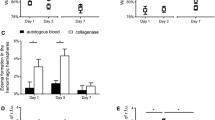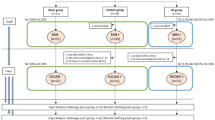Abstract
Acute brain edema formation contributes to brain injury after intracerebral hemorrhage (ICH). It has been reported that hyperbaric oxygen (HBO) is neuroprotective in cerebral ischemia, subarachnoid hemorrhage, and brain trauma. In this study, we investigated the effects of HBO on brain edema following ICH in rats.
Male Sprague-Dawley rats received intracerebral infusion of autolo-gous whole blood, thrombin, or ferrous iron. HBO (100% O2, 3.0 ATA for 1 h) was initiated 1 h after intracerebral injection. Control rats were exposed to air at room pressure. Brains were sampled at 24 or 72 h for water content, ion measurement, and Western blot analysis. We found that 1 session of HBO reduced perihematomal brain edema (p < 0.05) 24h after ICH. HBO also reduced heat shock protein-32 (HSP-32) levels (p < 0.05) in ipsilateral basal ganglia 24 h after ICH. However, HBO failed to attenuate thrombin-induced brain edema and exaggerated ferrous iron-induced brain edema (p < 0.05). Three sessions of HBO also failed to reduce brain edema 72 h after ICH.
In summary, HBO reduced early perihematomal brain edema and HSP-32 levels in brain. HBO-related brain protection does not occur through reduction in thrombin toxicity because HBO failed to attenuate thrombin-induced brain edema. Our results also indicate that HBO treatment after hematoma lysis for ICH may be harmful, since HBO amplifies iron-induced brain edema.
Access this chapter
Tax calculation will be finalised at checkout
Purchases are for personal use only
Preview
Unable to display preview. Download preview PDF.
Similar content being viewed by others
References
Carhuapoma JR, Wang PY, Beauchamp NJ, Keyl PM, Hanley DF, Barker PB (2000) Diffusion-weighted MRI and proton MR spec-troscopic imaging in the study of secondary neuronal injury after intracerebral hemorrhage. Stroke 31: 726–732
Henninger N, Kuppers-Tiedt L, Sicard KM, Gunther A, Schneider D, Schwab S (2006) Neuroprotective effect of hyperbaric oxygen therapy monitored by MR-imaging after embolic stroke in rats. Exp Neurol 201: 316–323
Hua Y, Keep RF, Hoff JT, Xi G (2007) Brain injury after intracerebral hemorrhage: the role of thrombin and iron. Stroke 38(2 Suppl): 759–762
Huang FP, Xi G, Keep RF, Hua Y, Nemoianu A, Hoff JT (2002) Brain edema after experimental intracerebral hemorrhage: role of hemoglobin degradation products. J Neurosurg 96: 287–293
Lee KR, Colon GP, Betz AL, Keep RF, Kim S, Hoff JT (1996) Edema from intracerebral hemorrhage: the role of thrombin. J Neurosurg 84: 91–96
Lou M, Eschenfelder CC, Herdegen T, Brecht S, Deuschl G (2004) Therapeutic window for use of hyperbaric oxygenation in focal transient ischemia in rats. Stroke 35: 578–583
Mayer SA, Lignelli A, Fink ME, Kessler DB, Thomas CE, Swarup R, Van Heertum RL (1998) Perilesional blood flow and edema formation in acute intracerebral hemorrhage: a SPECT study. Stroke 29: 1791–1798
Mendelow AD, Bullock R, Teasdale GM, Graham DI, McCulloch J (1984) Intracranial haemorrhage induced at arterial pressure in the rat. Part 2: Short term changes in local cerebral blood flow measured by autoradiography. Neurol Res 6: 189–193
Mink RB, Dutka AJ (1995) Hyperbaric oxygen after global cerebral ischemia in rabbits reduces brain vascular permeability and blood flow. Stroke 26: 2307–2312
Nakamura T, Keep RF, Hua Y, Schallert T, Hoff JT, Xi G (2004) Deferoxamine-induced attenuation of brain edema and neurological deficits in a rat model of intracerebral hemorrhage. J Neurosurg 100: 672–678
Nath FP, Kelly PT, Jenkins A, Mendelow AD, Graham DI, Teasdale GM (1987) Effects of experimental intracerebral hemorrhage on blood flow, capillary permeability, and histochemistry. J Neurosurg 66: 555–562
Qin Z, Karabiyikoglu M, Hua Y, Silbergleit R, He Y, Keep RF, Xi G (2007) Hyperbaric oxygen-induced attenuation of hemorrhagic transformation after experimental focal transient cerebral ischemia. Stroke 38: 1362–1367
Qureshi AI, Ling GS, Khan J, Suri MF, Miskolczi L, Guterman LR, Hopkins LN (2001) Quantitative analysis of injured, necrotic, and apoptotic cells in a new experimental model of intracerebral hemorrhage. Crit Care Med 29: 152–157
Rockswold SB, Rockswold GL, Defillo A (2007) Hyperbaric oxygen in traumatic brain injury. Neurol Res 29: 162–172
Sharp FR, Bernaudin M (2004) HIF1 and oxygen sensing in the brain. Nat Rev Neurosci 5: 437–448
Sheffield PJ (1998) Measuring tissue oxygen tension: a review. Undersea Hyperb Med 25: 179–188
Singhal AB (2007) A review of oxygen therapy in ischemic stroke. Neurol Res 29: 173–183
Tanaka A, Yoshinaga S, Nakayama Y, Kimura M, Tomonaga M (1996) Cerebral blood flow and clinical outcome in patients with thalamic hemorrhages: a comparison with putaminal hemorrhages. J Neurol Sci 144: 191–197
Wagner KR, Hua Y, de Courten-Myers GM, Broderick JP, Nishimura RN, Lu SY, Dwyer BE (2000) Tin-mesoporphyrin, a potent heme oxygenase inhibitor, for treatment of intracerebral hemorrhage: in vivo and in vitro studies. Cell Mol Biol (Noisy-le-grand) 46: 597–608
Wu J, Hua Y, Keep RF, Schallert T, Hoff JT, Xi G (2002) Oxidative brain injury from extravasated erythrocytes after intracerebral hemorrhage. Brain Res 953: 45–52
Wu J, Hua Y, Keep RF, Nakamura T, Hoff JT, Xi G (2003) Iron and iron-handling proteins in the brain after intracerebral hemorrhage. Stroke. 34: 2964–2969
Xi G, Keep RF, Hoff JT (1998) Erythrocytes and delayed brain edema formation following intracerebral hemorrhage in rats. J Neurosurg 89: 991–996
Xi G, Wagner KR, Keep RF, Hua Y, de Courten-Myers GM, Broderick JP, Brott TG, Hoff JT (1998) The role of blood clot formation on early edema development following experimental intracerebral hemorrhage. Stroke 29: 2580–2586
Xi G, Keep RF, Hua Y, Xiang J, Hoff JT (1999) Attenuation of thrombin-induced brain edema by cerebral thrombin preconditioning. Stroke 30: 1247–1255
Xi G, Hua Y, Bhasin RR, Ennis SR, Keep RF, Hoff JT (2001) Mechanisms of edema formation after intracerebral hemorrhage: effects of extravasated red blood cells on blood flow and blood-brain barrier integrity. Stroke 32: 2932–2938
Xi G, Keep RF, Hoff JT (2002) Pathophysiology of brain edema formation. Neurosurg Clin N Am 13: 371–383
Xi G, Fewel ME, Hua Y, Thompson BG Jr, Hoff JT, Keep RF (2004) Intracerebral hemorrhage: pathophysiology and therapy. Neurocrit Care 1: 5–18
Xi G, Keep RF, Hoff JT (2006) Mechanisms of brain injury after intracerebral haemorrhage. Lancet Neurol 5: 53–63
Yin D, Zhang JH (2005) Delayed and multiple hyperbaric oxygen treatments expand therapeutic window in rat focal cerebral ischemic model. Neurocrit Care 2: 206–211
Zazulia AR, Diringer MN, Videen TO, Adams RE, Yundt K, Aiyagari V, Grubb RL Jr, Powers WJ (2001) Hypoperfusion without ischemia surrounding acute intracerebral hemorrhage. J Cereb Blood Flow Metab 21: 804–810
Zhang JH, Lo, T, Mychaskiw G, Colohan A (2005) Mechanisms of hyperbaric oxygen and neuroprotection in stroke. Pathophysiology 12: 63–77
Author information
Authors and Affiliations
Editor information
Editors and Affiliations
Rights and permissions
Copyright information
© 2008 Springer-Verlag
About this paper
Cite this paper
Qin, Z., Xi, G., Keep, R.F., Silbergleit, R., He, Y., Hua, Y. (2008). Hyperbaric oxygen for experimental intracerebral hemorrhage. In: Zhou, LF., et al. Cerebral Hemorrhage. Acta Neurochirurgica Supplementum, vol 105. Springer, Vienna. https://doi.org/10.1007/978-3-211-09469-3_23
Download citation
DOI: https://doi.org/10.1007/978-3-211-09469-3_23
Publisher Name: Springer, Vienna
Print ISBN: 978-3-211-09468-6
Online ISBN: 978-3-211-09469-3
eBook Packages: MedicineMedicine (R0)




